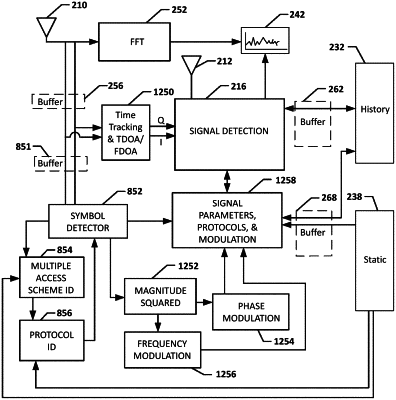| CPC H04B 17/309 (2015.01) [H04B 17/20 (2015.01); H04B 17/23 (2015.01); H04B 17/26 (2015.01); H04B 17/27 (2015.01); H04B 17/29 (2015.01); H04W 24/08 (2013.01); H04W 24/10 (2013.01); H04W 64/00 (2013.01); H04B 17/24 (2015.01); H04W 24/04 (2013.01)] | 20 Claims |

|
1. A system for signal detection or interference detection in an electromagnetic environment, comprising:
at least one receiver operable to receive electromagnetic environment data;
at least one node including at least one signal processor operable to process the electromagnetic environment data; and
at least one computing system in network communication with the at least one node;
wherein the at least one receiver is in communication with the at least one node;
wherein the at least one signal processor is operable to process signal data using compressed data for deltas from at least one baseline;
wherein the at least one signal processor is operable to determine modulation applied to at least one signal;
wherein the at least one signal processor is operable to demodulate the at least one signal to identify payload data;
wherein the at least one node is operable to receive and analyze processed signal data from the at least one signal processor;
wherein the at least one node is operable to send the analyzed, processed signal data to the at least one computing system;
wherein the at least one node is operable to identify the at least one signal based upon whether a signal parameter of the at least one signal matches any signal parameters in a signal characteristic listing data in a database including hardware parameters;
wherein the hardware parameters include antenna position, antenna type, orientation, azimuth, gain, and/or equivalent isotropically radiated power (EIRP) for a transmitter associated with the at least one signal; and
wherein the at least one node is operable to analyze the processed signal data by conducting a first fast Fourier transform (FFT) analysis and a second FFT analysis, aggregating the first FFT analysis and the second FFT analysis in order to create at least one baseline to be used in reporting, and comparing incoming FFTs to the at least one baseline in order to detect potential conflicts or interference with the at least one signal.
|